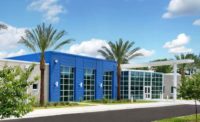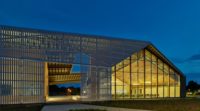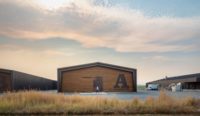Repurposed School Building Empowers Students
Protecting Communities During Storms
.jpg?1723577767)
Image courtesy of RG Architects
Increasingly, our schools need to be well-appointed places of modern learning and also durable structures in the event of natural disasters such as Florida’s seasonal hurricanes. That is one reason that, in our renovation work at Franklin Park Elementary School (FPES) in Fort Myers’s Dunbar community, Matern Professional Engineering worked with industry colleagues and partners to ensure that the school’s shelter would be available to protect students, staff and members of the surrounding community. In this way, and many others, FPES has the chance to enjoy an entirely new paradigm of what it means to be a “community school” on a previously underutilized location.
The original school was racially segregated and constructed long before modern hurricane codes were in place. FPES needed substantial rework to become a sturdy shelter to withstand Florida’s notorious storms. The mechanical, electrical, and plumbing (MEP) work our company needed to accomplish had to meet the standards for an “enhanced hurricane protection area.” This means the shelter must not only be able to withstand the fury of the storms but also have continuous power and ventilation operating independently from the rest of the school (which is critical in emergency situations).
In cooperation with our project partners, we worked to ensure the shelter met the International Code Council (ICC) 500 design and construction standards for proper mechanical ventilation systems. The Enhanced Hurricane Protection Area (EHPA) for FPES encompassed 51 percent of the overall project footprint, meaning classrooms also needed to be incorporated into the shelter plan. Our team had to be creative in designing this system so that it would fit within the established building footprint, as the size of the new school was not subject to alterations.
The shelter will be a haven not only for FPES faculty and students but also for members of the surrounding community who might not have anywhere else to go during a hurricane. With guaranteed electricity and proper ventilation, people waiting out the weather will be both safe and comfortable. The importance of this open-hearted initiative for all people in this community was doubly important considering FPES’s history as a one-time segregated school.
Our team has demolished all but one of the campus’s existing buildings. Working in conjunction with the architect of record, RG Architects, we have reconfigured that last standing structure as a state-of-the-art Media & Community Center to help the community’s students learn and apply digital tools of education.
The new school is also outward facing. The new community center includes a place where FPES officials will work with charitable organizations for the good of the Dunbar community and the city of Fort Myers. Inside the community center, students and people from the neighborhood will be able to get health checkups—including mental health assessments—thanks to the services of Lee Health. Additionally, the United Way will be on hand to help families in need with clothes and blankets. Students will learn firsthand the value of serving others in their community.
That mission of greater outreach will also get a boost, thanks to the presence of Florida Gulf Coast University. By being present at FPES, personnel from the college will be able to answer questions students might have about potential academic paths or career options.
Due to the school's age and the necessity of tearing down so many of the previously standing buildings, project funding was initially a hurdle. However, given our belief in the mission of creating a new type of campus for the Dunbar community, Matern Professional Engineering was able to work creatively with our partners to solve engineering and other challenges in time for the school to open for the 2024-25 school year.
When conceiving educational environments for 21st-century learning, it is crucial to acknowledge the past while simultaneously pointing the way toward a more equitable future. In a Fort Myers area where diversity flourishes, the new school campus, rising on the grounds of a once-segregated institution, stands as a symbol of progress, embodies a commitment to equity, and prepares future generations to thrive in an interconnected world.
Looking for a reprint of this article?
From high-res PDFs to custom plaques, order your copy today!







